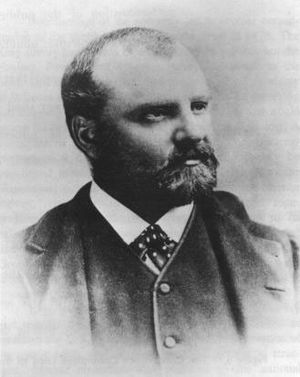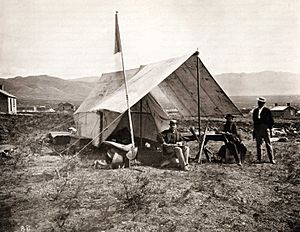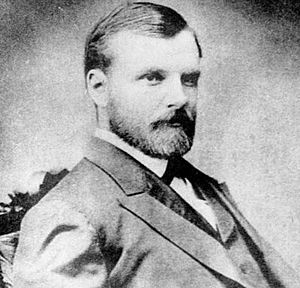Clarence King facts for kids
Quick facts for kids
Clarence King
|
|
|---|---|
 |
|
| 1st Director of the United States Geological Survey | |
| In office 1879–1881 |
|
| Succeeded by | John Wesley Powell |
| Personal details | |
| Born | January 6, 1842 Newport, Rhode Island, USA |
| Died | December 24, 1901 (aged 59) Phoenix, Arizona, USA |
| Signature |  |
| Alma mater | Yale University |
| Known for | Exploration of the Sierra Nevada |
| Scientific career | |
| Fields | Geology |
| Institutions | U.S. Geological Survey |
Clarence Rivers King (born January 6, 1842 – died December 24, 1901) was an American geologist, mountaineer, and author. He was the very first director of the United States Geological Survey (USGS). He led the USGS from 1879 to 1881. President Rutherford B. Hayes chose him for this important role. King was well-known for exploring the Sierra Nevada mountain range.
Contents
Clarence King's Early Life and Schooling
Clarence King was the son of James Rivers King and Florence Little King. His father worked for a family business that traded with China. This meant his father was often away from home. Sadly, his father died in 1848. Clarence was mostly raised by his mother. By 1848, his two siblings had also passed away.
Clarence became interested in exploring nature and natural history early on. His mother and Reverend Dr. Roswell Park encouraged this interest. Reverend Park was the head of the Christ Church Hall school in Pomfret, Connecticut. Clarence attended this school until he was ten.
After that, he went to schools in Boston and New Haven. At age thirteen, he was accepted into the famous Hartford High School. He was a good student and a strong athlete. Even though he was short, he was very strong.
His mother received money from the King family business. But the business ran into problems and closed in 1857. For a few years, they faced money troubles. During this time, Clarence also suffered from a serious sadness. In July 1860, his mother married George S. Howland. Mr. Howland paid for Clarence to attend the Sheffield Scientific School at Yale College in 1860.
College Life and First Jobs
At Yale, King focused on "applied chemistry." He also studied physics and geology. One of his most inspiring teachers was James Dwight Dana. Dana was a respected geologist who had traveled on a science trip around the world. King earned his degree in July 1862. That summer, he and friends borrowed a Yale rowboat. They took a trip along Lake Champlain and Canadian rivers. Then they returned to Yale for a rowing race.
In October 1862, King visited his old professor, George Jarvis Brush. He heard Brush read a letter from William Henry Brewer. The letter described climbing Mount Shasta in California. At the time, people thought it was the tallest mountain in the United States. King started reading more about geology. He went to a lecture by Louis Agassiz. Soon, he wrote to Brush saying he wanted to be a geologist. He was also very interested in descriptions of the Alps by John Tyndall and John Ruskin.
In late 1862 or early 1863, King moved to New York City. He shared an apartment with James Terry Gardiner. Gardiner was a close friend from high school and college. They spent time with American artists, writers, and architects. These friends admired Ruskin's ideas. In February 1863, King helped start a group called the Association for the Advancement of Truth in Art. He became its first secretary. But King really wanted to see the mountains of the American West. His friend Gardiner was also unhappy with law school.
By May 1863, King, Gardiner, and a friend named William Hyde traveled west. They took a train to Missouri. Then they joined a wagon train. They left the wagon train at Carson City, Nevada. King and Gardiner soon went on to California. There, King joined the California Geological Survey without pay. He worked with famous geologists like William H. Brewer and Josiah D. Whitney. Later, Gardiner and Richard D. Cotter also joined.
In July 1864, King and Cotter climbed a peak in the Eastern Sierra for the first time. King named it Mount Tyndall to honor one of his heroes. From there, they saw several even higher peaks. One of these later became known as Mount Whitney.
In September 1864, President Abraham Lincoln made the Yosemite Valley area a public park. King and Gardiner were asked to map the boundary around Yosemite Valley. They returned to the East Coast through Nicaragua that winter. King got sick with malaria several times in 1865. Meanwhile, Whitney worked to get money for more survey projects. King, Gardiner, Whitney, and Whitney's wife sailed back to San Francisco in the fall. Whitney arranged a survey project for King and Gardiner. This project was in the Mojave Desert and Arizona. It was supported by the U.S. Army.
They returned to San Francisco in the spring. King went back to Yosemite in summer 1866 to take more notes for Whitney. When King heard his stepfather had died, he and Gardiner left the Whitney survey. They sailed back to New York. They had been planning their own survey of the Great Basin area for some time. In late 1866, King went to Washington to ask Congress for money for his survey. In 1871, he was chosen to be a member of the American Philosophical Society.
The Fortieth Parallel Survey and a Diamond Discovery

King explained how his research would help develop the American West. He received money from the government. In 1867, he was named U.S. Geologist for the Geological Exploration of the Fortieth Parallel. This project was often called the Fortieth Parallel Survey. He convinced Gardiner to be his second-in-command. They put together a team that included Samuel Franklin Emmons, Arnold Hague, A. D. Wilson, photographer Timothy H. O'Sullivan, and artist Gilbert Munger.
For the next six years, King and his team explored areas from eastern California to Wyoming. During this time, he also wrote his famous book, Mountaineering in the Sierra Nevada (1872).
While King was finishing the 40th Parallel Survey, there was exciting news in the western US. People were talking about a secret diamond deposit. King and some of his team found the secret location in northwest Colorado. They proved it was a trick, now known as the Diamond hoax of 1872. By showing this fraud, King became famous around the world.
In 1878, King published Systematic Geology. This book was Volume 1 of the Report of the Geological Exploration of the Fortieth Parallel. In it, he described the geological history of the West. He explained it as a mix of slow, steady changes (uniformitarianism) and sudden, powerful events (catastrophism). This book was very well-received. It is called "one of the great scientific works of the late nineteenth century."
In 1879, the US Congress combined several geological surveys. They created the United States Geological Survey. King was chosen to be its first director. He took the job knowing it would be for a short time. He resigned after twenty months. During his time, he helped organize the new agency. He focused on studying geology related to mining. James Garfield chose John Wesley Powell to take his place.
In the years after, King left the scientific world. He tried to make money using his knowledge of mining geology. However, his mining projects were not successful enough. He had expensive tastes in art, travel, and living well. He ended up owing a lot of money. He had many friends, including Henry Brooks Adams and John Hay, who admired him greatly. But he suffered from health problems and sadness.
Death and Lasting Impact
Clarence King died of tuberculosis in Phoenix, Arizona. He was buried in Newport, Rhode Island. Several places are named in his honor. These include Kings Peak in Utah, Mount Clarence King and Clarence King Lake at Shastina, California. King Peak in Antarctica is also named after him.
The US Geological Survey Headquarters Library in Reston, Virginia, is also known as the Clarence King Library.
Images for kids






